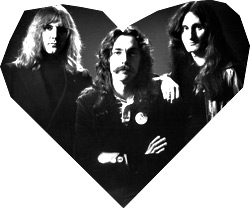Rush is sometimes described as the whitest rock band in the world. Geddy Lee’s high-pitched banshee-like wail can sometimes even make Morrissey sound as buttery as Al Green. I think that even when one Anglophile finds out another Anglophile listens to Rush, they are like, “Damn, you’re white!”
As a member of a minority in the U.S. (which I am), admitting to your family that you’re a fan might possibly be the ultimate taboo. It might even transcend the turbulence and alienation of confessing homosexuality. The shock. The horror. The confusion. Most likely your family won’t even know who Rush are, and if so, you might be in the clear—but one can only be so lucky. It wouldn’t surprise me if there were a black kid somewhere, as I type this, who is attempting to extol the virtues of Geddy Lee’s bass chops on “Overture/The Temples of Syrinx” just before being shamed back into secrecy by his lesbian sister.
Living in South San Diego in the early ’80s, I was a typical preteen. On sunny Saturdays my dad would blast his soul and funk records and the cholos would drive by in their impeccably waxed cars bumping oldies. When I was about 8, I received my first hip-hop mix tape, and witnessing a B-boy’s greasy Jheri-curled head gyrating effortlessly on the marble floor in front of the local theater was probably the single most exciting public spectacle I had experienced up to that point. Then I found rock.
The kids I hung out with were a motley bunch from various ethnic backgrounds: Mexican, Guamanian, and, in my case, African-American and Filipino. We got into rock music to escape the predictable doldrums of neighborhood life. Rush seemed to be the puzzle piece that fit perfectly into the obsessive trajectory toward male puberty. First it was insects, next military weaponry, after that Star Wars (duh), then Dungeons & Dragons, and, of course, Neal Peart’s drum set.
Neal Peart’s drum set was fodder for hours of adoration and debate within my group of friends. It was bigger, shinier, and more accessorized than anyone else’s—and he could play it with a level of technicality that was just incomprehensible to us. We would stare at live pictures trying to identify which piece made what sound on which song: “That’s gotta be the glockenspiel!” I remember one of my friends practically getting into a fistfight with this fat loudmouth kid over the pronunciation of Neil’s name. “Puurrrrt,” my friend said. “Peee-urrrrt,” the other kid snidely claimed. They had to be separated.
My friends and I had a quasi-rehearsal space in my garage that resembled Fat Albert and the gang’s junkyard jam studio. We had a chalkboard set up with our band name, “YYZ” (Rush’s classic instrumental track, complete with multiple time signatures), drawn on it. My drum set consisted of whatever crap was lying around that I could beat on. I vividly remember that for my snare drum I used a little wooden recipe box, and for drumsticks I repurposed some old nunchucks I’d made from a thick broomstick handle when we were all going through our martial-arts phase. I had originally painted the nunchucks silver, and when I drummed the paint would bleed off onto my hands. By the end of rehearsal, I looked like one of those gas-huffing Romanian kids covered in Auralac.
My dad was a man’s man originally from southern Texas, a hardened Vietnam vet. Most of my leisure activities evoked bewilderment and regret from my pops, but this newfound music interest seemed to take his feelings of perplexity to a new level. He would peer into the garage and just shake his head. “Actin’ like a fool,” he’d say to me.
I used to try make my mom listen to Rush on my portable Panasonic cassette player. Looking back, I guess it was a bit of a stretch to think I could turn her on to a Canadian prog-rock power trio that put out concept albums based on dystopian tales set in the year 2112, since she was still just getting a grasp on American culture. Listening to AM Gold and Freddie Aguilar was probably the most adventurous she had ever gotten with music. I would think to myself, “She’ll love the intro to ‘The Trees,’ she just hasn’t heard it enough.” I’d turn up a highly technical passage for her to hear, and she would just grimace and in her hard Filipino accent say, “Aye, it’s soooo ogly!”
As I got older, I obsessed less over Rush and moved on to other bands. I knew I wanted to hang out with girls, and telling them you’re a Rush fan usually isn’t your biggest selling point. It’s kind of like saying, “Hey, I still play with toys while I take a bath, do you wanna make out?” Like so many people, I honestly felt the albums following Moving Pictures just didn’t do it for me, though I was, and still am, a fan at heart.
I eventually graduated to playing real instruments. As a musician, I’ve always embraced the music-nerd side of me cultivated by hours of listening to Rush. I’ve learned that no matter what type of musician you are, if you have the mettle to flawlessly execute Rush riffs, you will be highly revered. But if you can flawlessly execute Rush riffs, wear clothes that fit, aren’t a virgin, and don’t hang around Guitar Center entering contests called “Guitarmageddon” and “Bass Wars”—then you will be a god.





